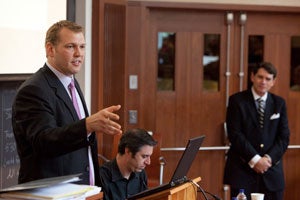As a spate of head injuries in football made national headlines in October, students in a Sports Law class at Harvard Law School got a firsthand account of the dangers—and consequences—of head trauma in the NFL.
“Always, the environment was that you play through any pain,” said Kevin Turner (below, right), the former fullback for the New England Patriots and the Philadelphia Eagles. “You got hit in the head … may see a few spots, but inside of a minute, it would certainly clear up [and you would] get your senses back and continue on.”
Turner was recently diagnosed with amyotrophic lateral sclerosis, also known as ALS or Lou Gehrig’s disease, and is one of 44 former athletes to date who have agreed to donate their brains after death to research.
Turner recalled the pressure to shake off a head injury and get back in the game fast, to ensure that “someone else doesn’t get your job.”
Also on hand in the class—taught by Harvard Law School Lecturer on Law Peter Carfagna—were Chris Nowinski, founder and chief executive of the non-profit Sports Legacy Institute (SLI), and Alan Schwarz, a sports reporter for The New York Times. Nowinski’s institute will be examining the brains of deceased athletes to study and document the effects of sports-related head trauma.
All three speakers emphasized the need for increased awareness of what SLI calls the “concussion crisis”—the risks of long-term brain damage that can result from repeated concussions brought on by football and other high-impact sports. These risks were reported in recent studies by the Center for the Study of Traumatic Encephalopathy (CSTE), a joint venture between SLI and Boston University School of Medicine (BUSM).
 “I was never aware of the idea that getting hit in the head too much could cause memory problems, depression, dementia,” said Nowinski, a former professional wrestler with World Wrestling Entertainment and former defensive tackle for the Harvard University football team.
“I was never aware of the idea that getting hit in the head too much could cause memory problems, depression, dementia,” said Nowinski, a former professional wrestler with World Wrestling Entertainment and former defensive tackle for the Harvard University football team.
“It’s just not something that’s on your radar screen as a young person,” he said.
National awareness of these risks was heightened dramatically in October, when, in the course of one weekend, helmet-first collisions caused the paralysis of a Rutgers University player, a concussion to Philadelphia Eagles receiver DeSean Jackson and injuries to three other NFL players, as Schwarz reported in The New York Times on Oct. 20.
Through medical studies and congressional hearings, CSTE has had a major impact this past year, bringing about changes into football at every level, including the NFL, said Carfagna, whose course is called “Sports and the Law: Examining the Legal History and Evolution of America’s Three ‘Major League’ Sports: MLB, NFL and NBA.”
CSTE “is not only solving the concussion crisis, as it first set out to do, but is also trying to make the game of football at all levels a safer game to play, so that the number of concussions is minimized,” Carfagna said.
The modifications include concussion-avoidance warning signs in all NFL locker rooms, rule changes to lessen helmet-to-helmet contact, and possible suspension of players who initiate such contact.
The NFL has granted a $1 million unrestricted gift to CSTE to do further studies on concussion prevention.
These actions mark a significant improvement over the NFL’s earlier stances on head injuries, Schwarz said. His reporting on former NFL players who have dementia helped instigate congressional hearings in 2009, he added.
Nowinski said that awareness of head injury risks is especially critical because of the major influence that the NFL has on youth football leagues.
“The real issue is that you can’t have this happening with kids. There’s no assumption of risk, there’s no informed consent for kids under 18,” he told the HLS class. “We do have the exact same game being played for 10-year-olds as we do for adults, and the NFL now realizes that and realizes that they’re being held accountable.”
– Sarah Marston
CSTE has played a key role in updating youth football rules in many states and is encouraging the possibility of federal legislation that would require adoption of such guidelines nationwide, Carfagna said. The changes include mandatory training of football coaches and trainers on CDC guidelines for the diagnosing and treatment of concussions, and the instigation of new post-concussion “return to play” pre-conditions.
